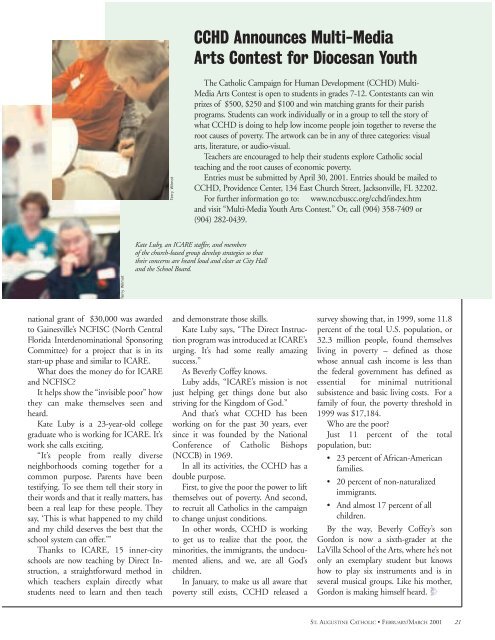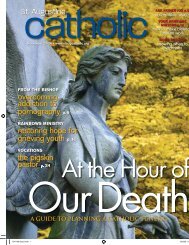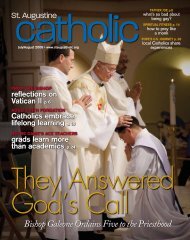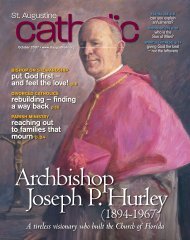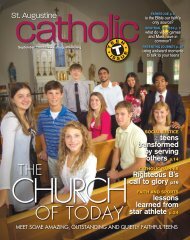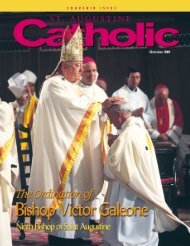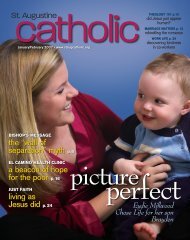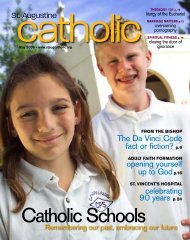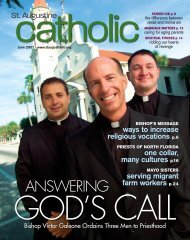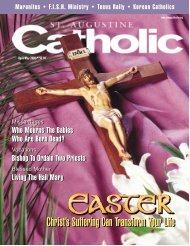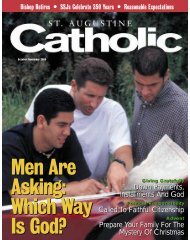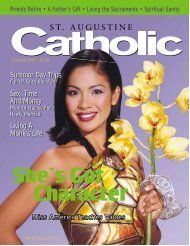This Lent Discover God's Love In A Retreat - St. Augustine Catholic
This Lent Discover God's Love In A Retreat - St. Augustine Catholic
This Lent Discover God's Love In A Retreat - St. Augustine Catholic
Create successful ePaper yourself
Turn your PDF publications into a flip-book with our unique Google optimized e-Paper software.
CCHD Announces Multi-Media<br />
Arts Contest for Diocesan Youth<br />
Terry Wilmot<br />
The <strong>Catholic</strong> Campaign for Human Development (CCHD) Multi-<br />
Media Arts Contest is open to students in grades 7-12. Contestants can win<br />
prizes of $500, $250 and $100 and win matching grants for their parish<br />
programs. <strong>St</strong>udents can work individually or in a group to tell the story of<br />
what CCHD is doing to help low income people join together to reverse the<br />
root causes of poverty. The artwork can be in any of three categories: visual<br />
arts, literature, or audio-visual.<br />
Teachers are encouraged to help their students explore <strong>Catholic</strong> social<br />
teaching and the root causes of economic poverty.<br />
Entries must be submitted by April 30, 2001. Entries should be mailed to<br />
CCHD, Providence Center, 134 East Church <strong>St</strong>reet, Jacksonville, FL 32202.<br />
For further information go to: www.nccbuscc.org/cchd/index.htm<br />
and visit “Multi-Media Youth Arts Contest.” Or, call (904) 358-7409 or<br />
(904) 282-0439.<br />
Kate Luby, an ICARE staffer, and members<br />
of the church-based group develop strategies so that<br />
their concerns are heard loud and clear at City Hall<br />
and the School Board.<br />
Terry Wilmot<br />
national grant of $30,000 was awarded<br />
to Gainesville’s NCFISC (North Central<br />
Florida <strong>In</strong>terdenominational Sponsoring<br />
Committee) for a project that is in its<br />
start-up phase and similar to ICARE.<br />
What does the money do for ICARE<br />
and NCFISC?<br />
It helps show the “invisible poor” how<br />
they can make themselves seen and<br />
heard.<br />
Kate Luby is a 23-year-old college<br />
graduate who is working for ICARE. It’s<br />
work she calls exciting.<br />
“It’s people from really diverse<br />
neighborhoods coming together for a<br />
common purpose. Parents have been<br />
testifying. To see them tell their story in<br />
their words and that it really matters, has<br />
been a real leap for these people. They<br />
say, ‘<strong>This</strong> is what happened to my child<br />
and my child deserves the best that the<br />
school system can offer.’”<br />
Thanks to ICARE, 15 inner-city<br />
schools are now teaching by Direct <strong>In</strong>struction,<br />
a straightforward method in<br />
which teachers explain directly what<br />
students need to learn and then teach<br />
and demonstrate those skills.<br />
Kate Luby says, “The Direct <strong>In</strong>struction<br />
program was introduced at ICARE’s<br />
urging. It’s had some really amazing<br />
success.”<br />
As Beverly Coffey knows.<br />
Luby adds, “ICARE’s mission is not<br />
just helping get things done but also<br />
striving for the Kingdom of God.”<br />
And that’s what CCHD has been<br />
working on for the past 30 years, ever<br />
since it was founded by the National<br />
Conference of <strong>Catholic</strong> Bishops<br />
(NCCB) in 1969.<br />
<strong>In</strong> all its activities, the CCHD has a<br />
double purpose.<br />
First, to give the poor the power to lift<br />
themselves out of poverty. And second,<br />
to recruit all <strong>Catholic</strong>s in the campaign<br />
to change unjust conditions.<br />
<strong>In</strong> other words, CCHD is working<br />
to get us to realize that the poor, the<br />
minorities, the immigrants, the undocumented<br />
aliens, and we, are all God’s<br />
children.<br />
<strong>In</strong> January, to make us all aware that<br />
poverty still exists, CCHD released a<br />
survey showing that, in 1999, some 11.8<br />
percent of the total U.S. population, or<br />
32.3 million people, found themselves<br />
living in poverty – defined as those<br />
whose annual cash income is less than<br />
the federal government has defined as<br />
essential for minimal nutritional<br />
subsistence and basic living costs. For a<br />
family of four, the poverty threshold in<br />
1999 was $17,184.<br />
Who are the poor?<br />
Just 11 percent of the total<br />
population, but:<br />
• 23 percent of African-American<br />
families.<br />
• 20 percent of non-naturalized<br />
immigrants.<br />
• And almost 17 percent of all<br />
children.<br />
By the way, Beverly Coffey’s son<br />
Gordon is now a sixth-grader at the<br />
LaVilla School of the Arts, where he’s not<br />
only an exemplary student but knows<br />
how to play six instruments and is in<br />
several musical groups. Like his mother,<br />
Gordon is making himself heard.<br />
ST. AUGUSTINE CATHOLIC • FEBRUARY/MARCH 2001 21


